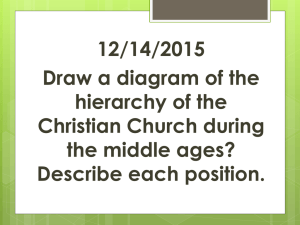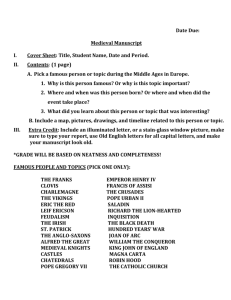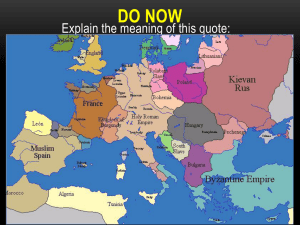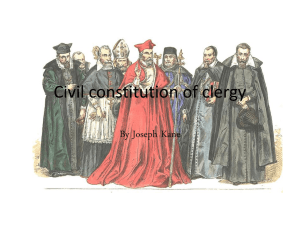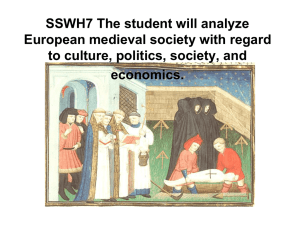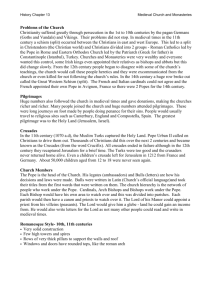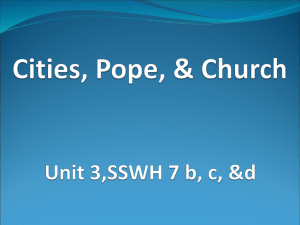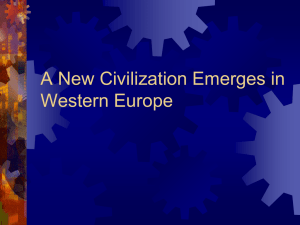Name - Long Branch Public Schools
advertisement
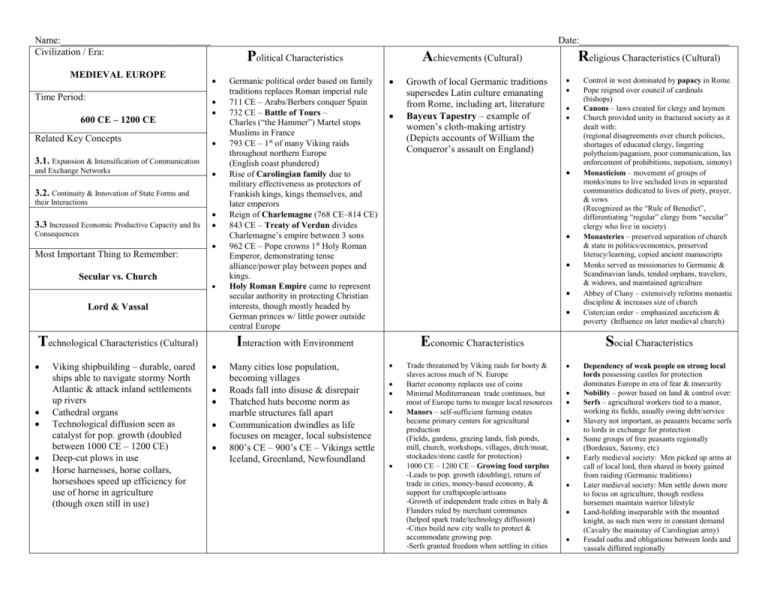
Name:_______________________________ Civilization / Era: MEDIEVAL EUROPE Time Period: 600 CE – 1200 CE Related Key Concepts Date:_______________________________ Political Characteristics 3.1. Expansion & Intensification of Communication and Exchange Networks 3.2. Continuity & Innovation of State Forms and their Interactions 3.3 Increased Economic Productive Capacity and Its Consequences Most Important Thing to Remember: Secular vs. Church Lord & Vassal Technological Characteristics (Cultural) Viking shipbuilding – durable, oared ships able to navigate stormy North Atlantic & attack inland settlements up rivers Cathedral organs Technological diffusion seen as catalyst for pop. growth (doubled between 1000 CE – 1200 CE) Deep-cut plows in use Horse harnesses, horse collars, horseshoes speed up efficiency for use of horse in agriculture (though oxen still in use) Germanic political order based on family traditions replaces Roman imperial rule 711 CE – Arabs/Berbers conquer Spain 732 CE – Battle of Tours – Charles (“the Hammer”) Martel stops Muslims in France 793 CE – 1st of many Viking raids throughout northern Europe (English coast plundered) Rise of Carolingian family due to military effectiveness as protectors of Frankish kings, kings themselves, and later emperors Reign of Charlemagne (768 CE–814 CE) 843 CE – Treaty of Verdun divides Charlemagne’s empire between 3 sons 962 CE – Pope crowns 1st Holy Roman Emperor, demonstrating tense alliance/power play between popes and kings. Holy Roman Empire came to represent secular authority in protecting Christian interests, though mostly headed by German princes w/ little power outside central Europe Achievements (Cultural) Many cities lose population, becoming villages Roads fall into disuse & disrepair Thatched huts become norm as marble structures fall apart Communication dwindles as life focuses on meager, local subsistence 800’s CE – 900’s CE – Vikings settle Iceland, Greenland, Newfoundland Interaction with Environment Growth of local Germanic traditions supersedes Latin culture emanating from Rome, including art, literature Bayeux Tapestry – example of women’s cloth-making artistry (Depicts accounts of William the Conqueror’s assault on England) Religious Characteristics (Cultural) Economic Characteristics Trade threatened by Viking raids for booty & slaves across much of N. Europe Barter economy replaces use of coins Minimal Mediterranean trade continues, but most of Europe turns to meager local resources Manors – self-sufficient farming estates became primary centers for agricultural production (Fields, gardens, grazing lands, fish ponds, mill, church, workshops, villages, ditch/moat, stockades/stone castle for protection) 1000 CE – 1200 CE – Growing food surplus -Leads to pop. growth (doubling), return of trade in cities, money-based economy, & support for craftspeople/artisans -Growth of independent trade cities in Italy & Flanders ruled by merchant communes (helped spark trade/technology diffusion) -Cities build new city walls to protect & accommodate growing pop. -Serfs granted freedom when settling in cities Control in west dominated by papacy in Rome. Pope reigned over council of cardinals (bishops) Canons – laws created for clergy and laymen Church provided unity in fractured society as it dealt with: (regional disagreements over church policies, shortages of educated clergy, lingering polytheism/paganism, poor communication, lax enforcement of prohibitions, nepotism, simony) Monasticism – movement of groups of monks/nuns to live secluded lives in separated communities dedicated to lives of piety, prayer, & vows (Recognized as the “Rule of Benedict”, differentiating “regular” clergy from “secular” clergy who live in society) Monasteries – preserved separation of church & state in politics/economics, preserved literacy/learning, copied ancient manuscripts Monks served as missionaries to Germanic & Scandinavian lands, tended orphans, travelers, & widows, and maintained agriculture Abbey of Cluny – extensively reforms monastic discipline & increases size of church Cistercian order – emphasized asceticism & poverty (Influence on later medieval church) Social Characteristics Dependency of weak people on strong local lords possessing castles for protection dominates Europe in era of fear & insecurity Nobility – power based on land & control over: Serfs – agricultural workers tied to a manor, working its fields, usually owing debt/service Slavery not important, as peasants became serfs to lords in exchange for protection Some groups of free peasants regionally (Bordeaux, Saxony, etc) Early medieval society: Men picked up arms at call of local lord, then shared in booty gained from raiding (Germanic traditions) Later medieval society: Men settle down more to focus on agriculture, though restless horsemen maintain warrior lifestyle Land-holding inseparable with the mounted knight, as such men were in constant demand (Cavalry the mainstay of Carolingian army) Feudal oaths and obligations between lords and vassals differed regionally Name:_______________________________ Civilization / Era: MEDIEVAL EUROPE Date:_______________________________ Political Characteristics (cont.) Time Period: 600 CE – 1200 CE Related Key Concepts 3.1. Expansion & Intensification of Communication and Exchange Networks 3.2. Continuity & Innovation of State Forms and their Interactions 3.3 Increased Economic Productive Capacity and Its Consequences Most Important Thing to Remember: Secular vs. Church Lord & Vassal 1073 CE – Investiture Controversy -Ongoing dispute over bishops’ loyalty as vassals owing military service to kings vs. jurisdiction of church land and authority -Antagonized by Pope Gregory VII, who excommunicated Holy Roman Emperor Henry IV for defiance on issue -Henry IV restored after 3 day barefoot snow walk as penance to pope -Gregory calls for Henry IV to be deposed in 1078 CE, leading to Henry ousting Gregory from Rome 1122 CE – Concordat of Worms – Tensions between pope and kings reduced as H.R.E. Henry V compromises rights to bishops’ appointments to Pope Calixtus II, who allows emperor to invest lay powers on bishops after papal appointment 1154 CE – Henry II of England institutes reforms strengthening crown at expense of nobility 1170 CE – Knights of Henry II murder Archbishop of Canterbury Thomas a Becket in cathedral over dispute on trying clerics in church vs. king’s courts. -Becket declared a saint by pope -Canterbury becomes pilgrimage site -Henry II loses respect to public & church Economic Characteristics Venice – Dominant sea power in Adriatic Sea (Competed with Pisa/Genoa in west Italy) Mediterranean cities traded with Muslims in N. Africa/Middle East & gained Silk Road goods Flanders – Dominated N. European trade in North Sea region (Ghent/Bruges/Ypres) Engaged in fishing & wool trade Silver Carolingian coinage returned to heavy use in later medieval period, followed by gold coinage thereafter Social Characteristics (cont.) Knights – main military feature of era -Armor/horse required funding, mostly from revenues gained from landholdings or rewards provided by kings/lords Noblewomen: -Entangled in web or marriage alliances -Rights of land entitled to man -Women guarded closely for their value in marrying off -Women had no political voice -Often maintained manors/estates while husband was away at war Common women: -Worked alongside men in fields -Some were artisans (sewing, weaving, spinning cloth)
